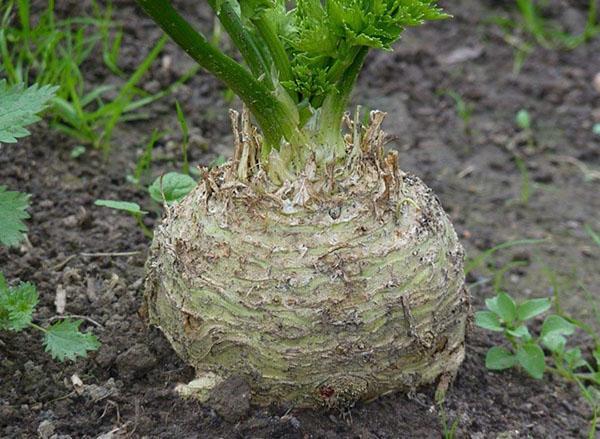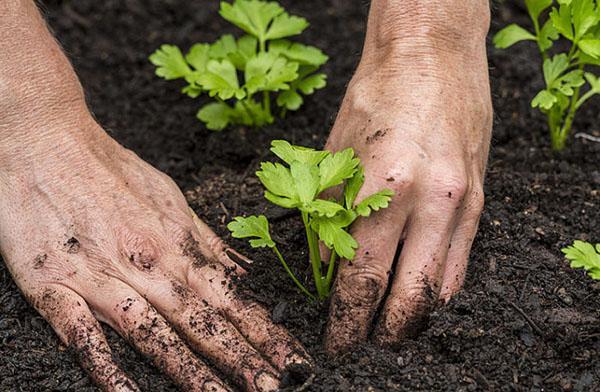Root celery: growing technique from seed to turnip
 Root celery it is problematic to immediately sow in ready-made beds, therefore they use the diving method. In February, seeds are planted in a small container. When they ascend, they begin to transplant.
Root celery it is problematic to immediately sow in ready-made beds, therefore they use the diving method. In February, seeds are planted in a small container. When they ascend, they begin to transplant.
Prepare a box with soil. In it, grooves are made with a pencil / pen. Seedlings are pre-spilled with water so that the roots do not break too much when removed. Then, at a short distance, they are placed in the soil. Before the start of garden work, seedlings are sent under special lighting.
Root celery transferred to open ground

It is recommended to plant a culture in permanent beds, which should already be prepared by that time. The ground is covered with a thin layer of sawdust so that the weeds sprout as late as possible and the seedlings become stronger.
After picking, root celery is given adequate care. Since the culture is hygrophilous, water is vital for it. Throughout the growth period, the farmer must take into account a number of such rules:
- Regular watering. An automatic irrigation system is installed or the liquid is applied under the root using a watering can three times a week. The more greenery on the bush, the more often the irrigation procedure is carried out.
- Root crop care. It should be understood that sawdust is introduced during planting. As soon as the turnip begins to form, it is freed by 1/3 of the mulch layer. If necessary, even cut the roots on it.
- Leaves. Yellowed and wilted foliage is removed. As a result, it dries up, smoothly passing into the root. This intervention contributes to the full formation of the fetus.
- Top dressing. Some fertilize the garden with herbal or ash infusions, which saturate the soil with potassium-phosphorus compounds. Others spray the foliage to make it look greener.
Of course, if the soil is fertile, then the last point is not necessary. At the same time, it is important to monitor the amount of precipitation, because you can flood the plants so that they will rot. Maintaining regular pruning will help the root crops to stretch decently out of the ground.
From time to time it is recommended to cut off young branches, which are very rich in vitamins. They are crushed, and then covered with salt and rolled up. This spice is ideal for meat dishes. Moreover, fresh herbs are used for pickling cucumbers.
Harvesting
In the 20th of September the long-awaited moment for the farmer will come - the harvest. Since root celery has a powerful rhizome, you will have to dig it out with a pitchfork. For successful storage of the fruit, the roots are partially cut off, and the petioles are also completely removed, leaving only 4-5 cm. Then they are buried in the sand, but so that the cut stems are visible. In the basement or in the cellar, it can be stored for a long time. If this is not possible, then the celery is dried.